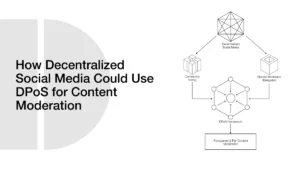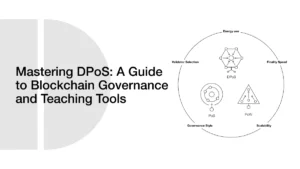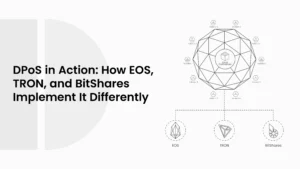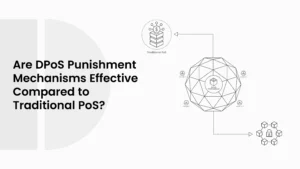How Do DPoS-Based Identity Chains Solve Web3 KYC Challenges with Privacy, Energy Efficiency
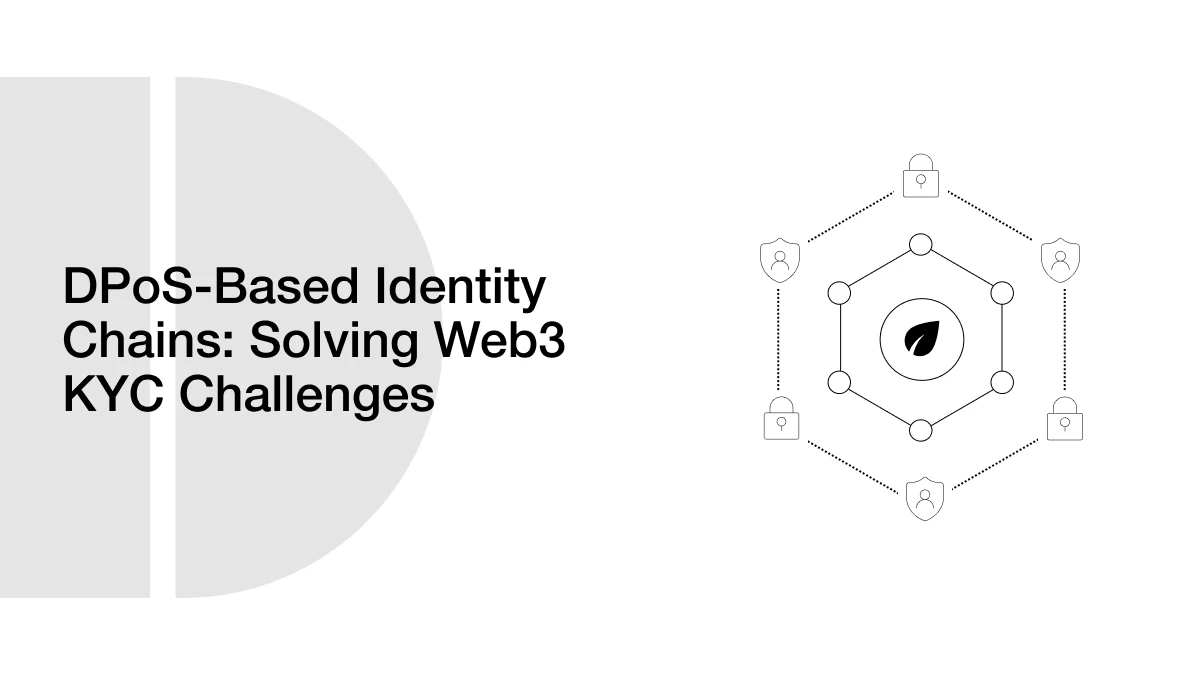
Web3 is changing the way people use the internet. Instead of companies controlling everything, users can own their data, their accounts, and even their money. However, this new approach also presents a significant issue: trust. Can you know the person you are dealing with is real and not a scammer? This is where identity verification comes in. In the old internet, big companies handled identity checks. In Web3, the idea is to achieve these goals in a decentralized manner, without concentrating all control in one company’s hands. One of the best ways to make this happen is by using DPoS, or Delegated Proof of Stake. The community chooses a small group of trusted individuals or organizations, known as validators, to verify information in this system.
- What Is KYC in Web3, And Why Is It Important?
- Problems with KYC in Current Web3 Systems
- Slow and Expensive Verification
- Privacy Concerns
- Cross-Border Compliance Issues
- Repeated Verification Across Platforms
- How DPoS Improves Identity Verification
- How Voting and Trusted Validators Work
- Why DPoS is Faster and Cheaper than Other Methods
- Role of Validators in Identity Approval
- What is a DPoS-Based Identity Chain?
- How It Works
- The Core Features
- Example: A Web3 User Experience
- Benefits of DPoS-Based Identity Chains for KYC
- Faster Verification Process
- Lower Costs for Businesses and Users
- Better Privacy with Encrypted Storage
- Cross-Platform Reuse of Verified Identity
- Easier Compliance with Laws
- Step-by-Step: How KYC Works on a DPoS Identity Chain
- Step 1 – Submitting Your Documents Once
- Step 2 – Validators Check and Confirm Your Identity
- Step 3 – Issuing Your Verified Identity Token
- Step 4 – Using Your Verified Identity Across Platforms
- Real-World Use Cases
- Crypto Exchanges
- NFT Marketplaces
- DeFi Lending Platforms
- Gaming and Metaverse Sign-Ups
- Cross-Border Payments
- Challenges and Risks of DPoS Identity Chains
- Risk of Validator Misbehavior
- Possible Security Breaches
- Global Legal Acceptance
- Technology Adoption Barriers
- Energy Efficiency of DPoS Identity Chains
- The Energy Challenge in Blockchain
- Why DPoS Uses Less Energy
- A Greener Path for Web3 KYC
- Future of Web3 KYC with DPoS Identity Solutions
- Rise of Decentralized Identity Standards
- Zero-Knowledge Proofs for More Privacy
- AI for Fraud Detection
- Greater Regulatory Alignment
- The Final Thoughts
- Frequently Asked Questions (FAQs)
- Glossary of Key Terms
PoS-based identity chain is a blockchain system that uses a validator method to confirm the online presence of users. It is capable of making the identity checks quicker, less expensive, and more confidential than the standard KYC (Know Your Customer) procedure. Instead of filling out forms and submitting your ID to every place you visit, you could verify your identity once and use it anywhere in Web3. This idea is still growing, but it can solve some of the most significant challenges in Web3. It is not only about speed; it is about providing users with more control over their data while keeping businesses compliant with the law.
What Is KYC in Web3, And Why Is It Important?
KYC stands for Know Your Customer. It is the process of checking who a person is before letting them use certain services. KYC has existed in the banking world for decades. They request your ID, proof of address, and, in some cases, other documents to ensure that you are who you claim to be. This assists in preventing fraud, money laundering, and other crimes.
In Web3, KYC works similarly, but the challenge is bigger. Web3 is global, meaning people from any country can join in. There is no single company or bank controlling everything. Because of this, platforms like crypto exchanges, NFT marketplaces, or DeFi lending services still need a way to follow laws and protect users from bad actors. This is where KYC comes in.
In the absence of KYC, there is a risk of scams and fraud. Anonymous accounts may be used by hackers or criminals to transfer stolen money or deceive other users. The KYC can mitigate such risks because it verifies the true identity of every individual before they have access to large transactions or sensitive services. Although Web3 is about privacy and decentralization, safety remains of great importance.
The key issue is that the existing KYC systems are slow, costly, and even unsafe to use. Individuals are usually required to post the same documents on various platforms, and this exposes them to the risk of having their personal information stolen. That is why numerous professionals think that there should be a superior solution, which preserves the security of KYC but suits the open, fast-paced world of Web3. Identity chains based on DPoS are supposed to be such a solution.
Problems with KYC in Current Web3 Systems
KYC in Web3 is important, but the current process is far from perfect. Most systems copy the traditional banking model, which does not fully work for a fast, global, and decentralized environment. The result is delays, higher costs, and privacy risks for users.
Slow and Expensive Verification
In traditional KYC systems, the verification process can take hours or even days. This is because every platform runs its own checks from scratch. In Web3, this can slow down new users who want to start trading or using a service right away. The cost is also high because each platform requires separate identity checks. These costs often get passed on to the user through fees.
| Problem | Impact on Users | Impact on Businesses |
| Slow Processing Time | Users wait hours or days to access services | Delays in onboarding new customers |
| High Verification Costs | Higher fees for using platforms | Extra expense for identity verification tools |
| Repetitive Checks | Users upload the same documents multiple times | Wasted resources on duplicate processes |
| Limited Global Reach | Some users get rejected due to country restrictions | Smaller customer base |
Privacy Concerns
Among the greatest problems of the existing KYC systems is the fact that you need to provide personal documents, such as your ID or passport, to all sites that you visit. The more you pass this data, the greater the chances of its theft during a hack. Privacy is important to many individuals in the Web3 world, and the existing KYC models contradict this concept.
If a single platform storing your data gets hacked, all the information can be leaked. This has happened many times in the past with big companies, and the damage can be huge. Once personal information is exposed, it can be used for identity theft, scams, or even blackmail.
Cross-Border Compliance Issues
Web3 is global, but laws vary by country. Some places have stringent KYC rules, while others are more relaxed. A crypto exchange that accepts users from multiple countries must follow many different legal requirements at once. This makes the process complicated and sometimes forces platforms to reject users from certain countries altogether.
For example, a platform in Europe may need to follow GDPR privacy laws while also following anti-money laundering rules from other regions. Balancing these rules often leads to slower KYC approval times and more paperwork.
Repeated Verification Across Platforms
A common complaint from Web3 users is that they have to go through KYC again and again for every new app or service. You will need to complete the verification process again on a different crypto exchange, despite having already done it previously. It is time-wasting and frustrates the onboarding process.
This redundancy in the long term gives the user a poor experience and makes certain individuals avoid using legitimate platforms. It also brings a greater threat of privacy violations since some of your documents are saved in more locations.
How DPoS Improves Identity Verification
Delegated Proof of Stake (DPoS) is a blockchain with a voting mechanism in which the users elect a small number of trusted validators. These validators confirm transactions and maintain network security. Identity verification in Web3 can be accomplished with the same concept.
Rather than each platform having to perform its own KYC checks, a network of validators would be able to verify identities once and then store them safely, enabling them to be reused across platforms.
How Voting and Trusted Validators Work
In DPoS, any user who holds tokens within the network can vote on validators. These validators are often companies, organizations, or individuals of good repute. They are encouraged to remain honest because the community selects them, and in case they cheat, they may be voted out.
In terms of identity verification, it implies that the community can choose reliable validators who adhere to high KYC and privacy requirements. After a validator verifies your identity, you can use that verification over and over again without the need to re-upload your documents.
Why DPoS is Faster and Cheaper than Other Methods
One of the biggest advantages of DPoS is speed. In proof-of-work (PoW) systems like Bitcoin, it can take minutes or even hours for transactions to be confirmed. In proof-of-stake (PoS) systems, it is faster but still not always efficient for handling identity checks. DPoS speeds this up by using only a small number of validators, making the process much quicker.
Because fewer validators are involved, the cost of verifying identities is lower. Businesses don’t have to pay for duplicate checks, and users don’t face as many extra fees.
| Consensus Type | Speed | Cost | Best For KYC? |
| Proof of Work (PoW) | Slow (minutes to hours) | High | No |
| Proof of Stake (PoS) | Medium | Medium | Possible but less efficient |
| Delegated Proof of Stake (DPoS) | Fast (seconds) | Low | Yes – ideal for reusable verification |
Role of Validators in Identity Approval
In a DPoS-based identity chain, validators would be responsible for:
- Checking the authenticity of user documents once
- Encrypting and storing verification details securely
- Issuing a “verified identity token” that users can present to any Web3 service
- Updating or revoking verification if a user’s details change or a fraud attempt is detected
This approach makes identity checks faster, more reliable, and much safer for users. Instead of sending sensitive documents to 10 different companies, you only send them once to a trusted validator network.
What is a DPoS-Based Identity Chain?
A DPoS-based identity chain is a blockchain network that implements identity verification via Delegated Proof of Stake (DPoS). Rather than multiple companies running their own KYC process, the identity chain becomes a familiar, trusted source of verified identities.
This implies that a person will only have to perform the identity verification process once and be able to use the same verification on various Web3 platforms without repeating the KYC process.
How It Works
Think of it like a passport system for Web3. You go to one trusted office (validator) and get your identity confirmed. After that, you receive a digital passport (a secure token or credential) stored on the blockchain.
You do not have to resend your documents when you register on a different exchange, NFT marketplace, DeFi lending application, etc. You just show your blockchain “passport,” and they can instantly confirm your verification.
The Core Features
A DPoS-based identity chain usually has these main parts:
- Validators who check and approve user identities.
- Encrypted storage for sensitive data so it’s safe from hackers.
- Identity tokens that prove verification without exposing private details.
- Reputation tracking ensures that validators stay honest.
Example: A Web3 User Experience
Let’s say a person wants to use three different Web3 services: a DeFi app, a crypto exchange, and a gaming platform. In today’s system, the user would have to go through KYC three separate times, uploading their passport, proof of address, and a selfie to each platform. This results in three sets of documents being stored in three different databases, which increases the user’s risk.
With a DPoS-based identity chain, the user would go through KYC just once. A validator would approve them and issue a digital identity token. When the user signs up for the exchange, the gaming platform, and the DeFi app, they simply connect their wallet, and the system instantly confirms their verified status from the identity chain. No repeated uploads, no extra waiting.
Benefits of DPoS-Based Identity Chains for KYC
Applying DPoS-based identity chain to KYC transforms a slow, repetitive process into a fast, secure, and reusable one. The model benefits both users and businesses since it reduces expenses, time, and enhances trust.
Faster Verification Process
In the case of conventional KYC, you may have to wait for hours or even days to be approved. Using the DPoS identity chain, once you have been verified, it will only take a few seconds on other platforms. The validators verify your documents once, and the verification can be reused. This allows new apps or services to onboard users instantly.
Lower Costs for Businesses and Users
Because the identity check is done once and reused, companies don’t have to pay for new verifications every time a customer signs up. This lowers business expenses and helps reduce user fees. Platforms can pass these savings on to their customers, making their services more affordable.
Better Privacy with Encrypted Storage
With a DPoS-based identity chain, personal data can be stored in encrypted form on the blockchain or even off-chain with secure access. This means no one can see your details without permission, and you don’t have to keep sending your ID to different companies, which reduces hacking risks.
Cross-Platform Reuse of Verified Identity
The biggest benefit for users is that once you’re verified, you can use your identity on many platforms without having to start over. This works for crypto exchanges, DeFi apps, NFT marketplaces, and even metaverse logins. Your identity token acts as a universal pass.
Easier Compliance with Laws
For businesses, compliance with regulations like anti-money laundering (AML) laws becomes easier. Since the validators follow legal requirements, platforms can trust that the identity information meets the standards they need. This helps them avoid legal trouble while still respecting user privacy.
| Benefit | For Users | For Businesses |
| Faster Verification | Access services instantly after first KYC | Quicker onboarding of customers |
| Lower Costs | Fewer extra fees | Reduced identity verification expenses |
| Better Privacy | Fewer document uploads, less data exposure | Lower risk of handling sensitive data |
| Cross-Platform Use | One KYC for multiple apps | Consistent compliance across platforms |
| Easier Compliance | Stay legal without losing privacy | Meet AML/KYC laws more easily |
Step-by-Step: How KYC Works on a DPoS Identity Chain
The process for verifying your identity on a DPoS-based identity chain is simple. Instead of repeating KYC every time you join a new Web3 service, you only go through it once. After that, your verification can be reused anywhere that supports the identity chain.
Step 1 – Submitting Your Documents Once
You start by sending your ID, proof of address, and other needed documents to the DPoS identity chain through a secure platform. This is the only time you’ll have to send these details.
Validators, who are trusted members of the network, review the information. The community chooses them for their good reputation and must follow strict privacy and compliance rules.
Step 2 – Validators Check and Confirm Your Identity
After your documents are delivered to the validators, they confirm that the documents are genuine and are yours. This can be verification of government databases, biometric scans, or fraud detection programs.
Since it is a DPoS system, a few validators are required to approve your identity. This accelerates the process, but it is safe.
Step 3 – Issuing Your Verified Identity Token
Once approved, a secure digital credential, commonly referred to as an identity token, is sent to you. You store this token in your Web3 wallet. It verifies that you have done KYC without revealing all your details. It’s like having a verified badge you can use instantly anywhere.
Step 4 – Using Your Verified Identity Across Platforms
When you join a new Web3 platform, like a DeFi exchange, NFT site, or metaverse game, you simply connect your wallet. The platform checks your identity token on the DPoS chain and confirms your verification in seconds. No more uploading documents over and over. No more long waiting times.
| Step | What Happens | User Benefit |
| Submit Documents | Upload ID, proof of address once | No repeated uploads |
| Validator Check | Community-chosen validators verify details | Faster approval |
| Token Issued | Secure identity token stored in wallet | Privacy protection |
| Cross-Platform Use | Token accepted on many platforms | Instant onboarding |
Real-World Use Cases
A DPoS-based identity chain isn’t just a theory. It can work in many real Web3 services where trust, speed, and compliance matter. The biggest value comes from letting users verify their identity once and use that same verification everywhere.
Crypto Exchanges
Most crypto exchanges require KYC before you can trade large amounts or withdraw funds. With a DPoS identity chain, users could sign up and get verified instantly by showing their identity token. This would cut waiting times from days to seconds, helping exchanges onboard more users quickly while staying compliant with laws.
NFT Marketplaces
NFT marketplaces often face fraud risks from fake sellers. By using a DPoS-based KYC system, marketplaces could verify artists and collectors without storing their sensitive data themselves. Buyers would know they’re dealing with verified accounts, which builds trust in the community.
DeFi Lending Platforms
DeFi lending platforms need to confirm that borrowers and lenders are legitimate. A DPoS-based identity chain allows them to do this without collecting piles of private documents. This keeps user privacy safe while still meeting anti-money laundering rules.
Gaming and Metaverse Sign-Ups
In the metaverse and online games that use blockchain assets, identity checks can help prevent cheating, bot accounts, and scams. A verified digital ID from a DPoS system lets players join instantly while giving game developers confidence they’re dealing with real people.
Cross-Border Payments
When sending money across borders, financial rules in different countries can slow things down. A DPoS identity chain could act as a global verification layer, making it easier for payment services to accept users from multiple countries without redoing KYC for each jurisdiction.
| Use Case | Problem Today | How DPoS Identity Chain Helps |
| Crypto Exchanges | Long onboarding times | Instant verified access |
| NFT Marketplaces | Fake seller scams | Verified creator badges |
| DeFi Lending | Risk of fraud | Secure borrower and lender verification |
| Gaming/Metaverse | Bots and fake accounts | Only real, verified players |
| Cross-Border Payments | Slow, repeated KYC checks | One verification accepted globally |
Challenges and Risks of DPoS Identity Chains
While DPoS-based identity chains can solve many problems in Web3 KYC, they are not perfect. Like any system, they come with risks and challenges that need to be addressed before they can be widely adopted.
Risk of Validator Misbehavior
DPoS works by having a small number of validators who confirm transactions or identities. If some of these validators act dishonestly, they could approve fake identities or misuse stored data.
The good news is that in most DPoS systems, dishonest validators can be voted out by the community, but the risk is still there.
Possible Security Breaches
Even though data can be stored in an encrypted form, no system is 100% safe from hacking. If a validator or storage provider is breached, private information could be exposed.
This is why strong encryption, regular audits, and security updates are critical for any identity chain.
Global Legal Acceptance
For DPoS-based identity chains to work everywhere, governments need to recognize them as valid forms of KYC. Right now, most countries still require identity checks to be done in traditional ways. Until regulations catch up, adoption might be slow.
Technology Adoption Barriers
Many Web3 platforms are still small or in early development stages. Some may not have the technical skills or budget to integrate with a DPoS identity chain. Without easy integration tools and developer support, adoption will take time.
| Risk | Why It’s a Problem | How to Reduce It |
| Validator Misbehavior | Fake or wrong approvals | Voting out bad validators, regular audits |
| Security Breaches | Data leaks and identity theft | Strong encryption, secure key storage |
| Legal Acceptance | Not recognized by all countries | Work with regulators, prove compliance |
| Technology Barriers | Hard for platforms to adopt | Provide APIs, developer tools |
Energy Efficiency of DPoS Identity Chains
One of the lesser-talked-about benefits of DPoS-based identity chains is their low energy use. Many people worry that blockchain technology uses too much electricity, especially after hearing about Bitcoin mining. But not all blockchains work the same way.
The Energy Challenge in Blockchain
Blockchains that use Proof of Work (PoW), like Bitcoin, require powerful computers to solve complex puzzles. This process uses huge amounts of electricity, about the same as a small country every year. That level of energy use is not only costly but also raises concerns about the environment.
For Web3 to grow and win public trust, it needs systems that are both secure and eco-friendly. This is where DPoS stands out.
Why DPoS Uses Less Energy
In DPoS, only a small group of validators processes transactions and verifies data, instead of thousands of computers racing against each other. This makes the process much faster and uses far less electricity. For KYC and identity chains, this is perfect because the network doesn’t need massive computing power to confirm identities.
| Consensus Type | Energy Usage Level | Example Networks | Good for KYC Identity Chains? |
| Proof of Work (PoW) | Very High | Bitcoin | No – too slow and costly |
| Proof of Stake (PoS) | Low | Ethereum 2.0 | Yes – but still more resource-heavy than DPoS |
| Delegated Proof of Stake (DPoS) | Very Low | Cosmos, EOS | Yes – fastest and most energy-efficient |
| Nominated Proof of Stake (NPoS) | Very Low | Polkadot | Yes – efficient with secure validation |
A Greener Path for Web3 KYC
By using DPoS for identity chains, platforms can keep verification fast and affordable while using a fraction of the energy required by other systems. This not only saves costs but also makes it easier to win support from eco-conscious users and regulators.
As more Web3 projects look to lower their carbon footprint, energy-efficient consensus models like DPoS could become the standard for decentralized KYC.
Future of Web3 KYC with DPoS Identity Solutions
DPoS-based identity chains are still a new idea, but they could become the standard way to handle KYC in Web3. As technology improves and laws adapt, these systems could offer even faster, safer, and more private verification.
Rise of Decentralized Identity Standards
One big step will be the growth of decentralized identity (DID) standards. These are frameworks that let users control their identity data directly, without handing it over to a company. Combined with DPoS, DID could let people carry a single, reusable KYC proof across the entire Web3 ecosystem.
Zero-Knowledge Proofs for More Privacy
Zero-knowledge proofs (ZKPs) are a type of cryptography that lets you prove something is true without revealing the actual data. In KYC, this could mean proving you are over 18 or from a certain country without sharing your passport or address.
Adding ZKPs to a DPoS identity chain would make verification both private and compliant with laws.
AI for Fraud Detection
Artificial intelligence could play a major role in the future of DPoS identity verification. AI can quickly spot fake IDs, detect unusual behavior, and flag possible fraud. This would help validators work faster and reduce human errors.
Greater Regulatory Alignment
Over time, more countries may update their financial laws to allow decentralized identity systems. This could open the door for global acceptance of DPoS-based KYC, making it possible to sign up for services in multiple countries without repeating the verification process.
| Innovation | Benefit for Users | Benefit for Businesses |
| Decentralized Identity (DID) | More control over personal data | Easier integration across platforms |
| Zero-Knowledge Proofs | Prove details without sharing documents | Stay compliant while protecting privacy |
| AI Fraud Detection | Faster, safer verification | Lower risk of onboarding fake users |
| Regulatory Alignment | Global access with one KYC | Larger, worldwide customer base |
The Final Thoughts
The way KYC works in Web3 today is far from perfect. It is slow, repetitive, and often puts user privacy at risk. A DPoS-based identity chain offers a better way forward. By verifying someone’s identity once and allowing them to use that verification everywhere, it saves time, cuts costs, and makes onboarding much smoother. For users, it means no more uploading documents again and again. For businesses, it means faster customer sign-ups, lower compliance costs, and reduced risk of data breaches. This approach also fits with the values of Web3, giving control back to the user while still keeping the system safe and legal.
There are still challenges. Validators must stay honest, systems must remain secure, and governments must update their laws to accept decentralized KYC. But as technology advances, especially with tools like decentralized identity, zero-knowledge proofs, and AI, the potential is huge. If Web3 is truly going to be global, secure, and user-friendly, solving KYC is a must. DPoS may be the bridge between today’s slow, centralized checks and tomorrow’s fast, privacy-first verification. The sooner platforms start adopting it, the sooner there could be a Web3 where trust and freedom work together.
Frequently Asked Questions (FAQs)
- What is a DPoS-based identity chain?
A DPoS-based identity chain is a blockchain system that uses Delegated Proof of Stake to verify identities. It allows users to complete KYC once and reuse that verification across many Web3 platforms. - How does DPoS make KYC faster?
DPoS uses a small group of trusted validators to approve transactions and identity checks. This reduces processing time from days to seconds compared to traditional systems. - Is a DPoS-based identity chain safe for my personal data?
Yes, when built correctly. Personal data can be encrypted and stored securely, and identity tokens can be used to prove verification without revealing sensitive details. - Can DPoS identity chains work in all countries?
Not yet. Some countries still require traditional KYC methods. But as laws change, more places may accept decentralized verification systems. - Why is DPoS better for energy use?
Unlike Proof of Work, DPoS doesn’t need thousands of computers running non-stop. Only a few validators handle the process, which saves a lot of electricity.
Glossary of Key Terms
- Web3: The next version of the internet that is decentralized and often uses blockchain.
- KYC (Know Your Customer): A process for checking who someone is before they can use a service.
- DPoS (Delegated Proof of Stake): A consensus method where token holders vote for trusted validators to process transactions.
- Validator: A trusted participant in a blockchain who confirms transactions and checks identities.
- Identity Token: A secure digital proof that someone has passed KYC without sharing personal details.
- Zero-Knowledge Proof: A way to prove something is true without sharing the actual data.
- Decentralized Identity (DID): A system where people control their own identity data without relying on one company.

